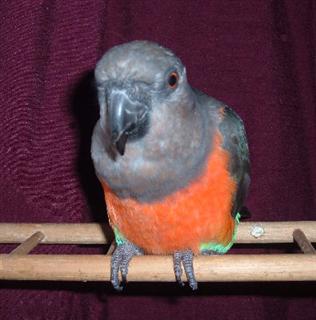Red Bellied Parrot
Scientific Name: Poicephalus rufiventris
Thu, 9th January, 2025 - 3:26 pm GMT
Sponsor Ads:

Alternative Name
Scientific Name: Poicephalus rufiventrisBasic Info
Red Bellied Parrots usually reach maturity at 12 months of age, when they will be about eight and a half inches in length. Red Bellied Parrots have grayish brown wings, heads, and backs. The lower back has a blue tinge, although it is predominantly yellow-green. The breasts, under-wing coverts, and cheeks are washed with orange. The under-wing coverts and thighs are aqua green. Red Bellied Parrots have black periopthalmic rings and red irises. Their bills are black and their feet are gray. Sexing may be achieved visually; males have orange bellies and females have green bellies. Immatures both have orange coloration over their bellies.
Health
Red Bellied Parrots should be fed a good basic seed or pellet diet supplemented with plenty of fresh fruits and vegetables, including greenfood. Wood offered to your Red Bellied Parrot will probably be much appreciated, and plenty of exercise is important as well. They should be housed in a cage which allows plenty of room for moving around and playing. Breeding Red Bellied Parrots should usually be provided with a nest box of about two feet high and ten inches square, filled with wood shavings and peat moss. Generally, Red Bellied Parrots will not breed until they are between three and four years of age. Breeding season usually occurs in the winter months. The average clutch consists of about four eggs laid over about eight days, and the incubation is achieved by the female alone. This lasts about 28 days, and by nine weeks of age the young Red Bellied Parrots are ready to leave the nests. Between 12 and 14 weeks of age, they will be fully independent.Habitat
N/ABehavior
Often considered to be the show-offs of the parrot world, the Red Bellied Parrot is often not as shy as other parrots, and some owners report that their birds will talk even more in the presence of company than they do when they are at home with people they know. In the wild, Red Bellied Parrots live in small groups or pairs. Although quieter than many parrots, Red Bellied Parrots are good talkers and can produce a variety of noises and sounds, both learned and instinctive. Although shy at times, Red Bellied Parrots are easily excited by new people and may talk excessively to attract attention! They are affectionate and loving with people they are familiar with and love attention. Once Red Bellied Parrots are acclimated, they become quite hardy. Before they are comfortable with their new handlers, they may be quite shy and some have even died flying into the mesh walls of their cages. After they settle in, Red Bellied Parrots become quite hardy and confiding. New birds should be allowed temperatures warmer than 68 degrees Fahrenheit, but after they are settled, they may be kept at temperatures as low as 50 degrees.Origin
AfricaHistory
The Red Bellied Parrot was first officially noted in 1845 by Ruppell. These birds are naturally occurring in eastern Africa, from central Ethiopia to northern Tanzania. Although wild caught birds may be shy, flighty, or reserved, captive bred and raised Red Bellied Parrots usually have sweet, confiding personalities and will seek out human attention and company.Common Foods
They eat fruits, seeds, and grain, living in woodlands or savannas.Sponsor Ads:
"The fact that an opinion has been widely held is no evidence whatever that is not uterly absurd; indeed, in view of the silliness of the majority of mankind, a wide-spread belief is more likely to be foolish than sensible." -- Bertrans Russell
Red Bellied Parrot
Coded by: BGID® | ALL RIGHTS RESERVED Copyright © 2000-2025
Disclaimer | Privacy | Report Errors / Contact | Credits








 President of the United States of America - Real Estate mogul, Pageant owner and now one of the most controversial men in political history.
President of the United States of America - Real Estate mogul, Pageant owner and now one of the most controversial men in political history.  Politician, US Vice President and President of the USA - Joseph Robinette Biden Jr.
Politician, US Vice President and President of the USA - Joseph Robinette Biden Jr.  versus
versus  Russia: 'The Evil Empire'? Are they all that bad or is it just the USA trying to portray Russia as bad because they are a world power with land bigger and a society very different from the USA ideal?
Russia: 'The Evil Empire'? Are they all that bad or is it just the USA trying to portray Russia as bad because they are a world power with land bigger and a society very different from the USA ideal?  Global warming has been in and out as the "latest" hot topic for many years. It is, according to modern scientists, the result of man-made industrial pollutants, clearing forested areas, agriculture, etc. But now they are thinking it started way before the Industrial Revolution...
Global warming has been in and out as the "latest" hot topic for many years. It is, according to modern scientists, the result of man-made industrial pollutants, clearing forested areas, agriculture, etc. But now they are thinking it started way before the Industrial Revolution... 
 Corona virus
Corona virus 
 Users with wide screen monitors can benefit from more content on every page.
Users with wide screen monitors can benefit from more content on every page.